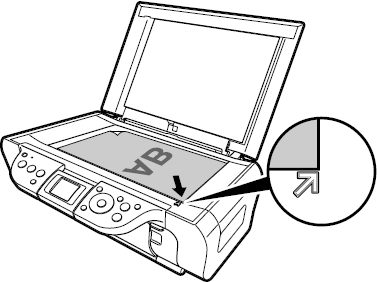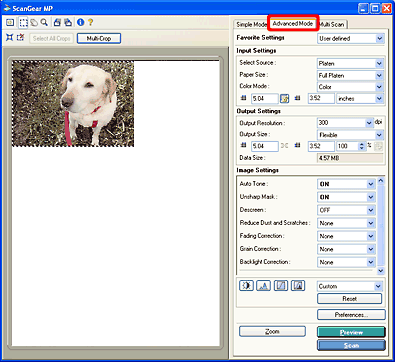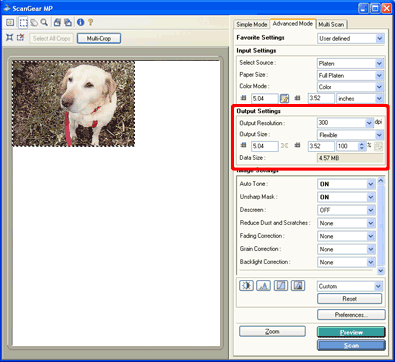Scan in Advanced Mode using MP150 / MP170 / MP450 driver (Windows)
| Article ID: ART158972 | | | Date published: 06/09/2015 | | | Date last updated: 08/18/2015 |
Description
Solution
Scanning an Image from an Application
You can scan an image from a TWAIN or WIA-compliant application and use the image in that application. The procedure to follow varies depending on the application. The following is only one example. For a detailed procedure, refer to the documentation for the application you are using.
- Place the document face-down on the platen glass.

- In the application, select the command to scan a document ([Import], [Acquire image], etc.).
- Select the scanner driver.
-
- To use ScanGear MP, select 'Canon MPxxx' (where xxx indicates your machine name).
- To use the WIA driver (in Windows XP only), select 'WIA-Canon MPxxx' (where xxx indicates your printer's model). (Advanced Mode options are not available using the WIA driver.
Note: To scan with the value previously set in [Adjust the quality of the scanned picture], select 'Custom Settings'.
- To use ScanGear MP, select 'Canon MPxxx' (where xxx indicates your machine name).
- In ScanGear MP dialog box, click 'Advanced Mode' tab to set detailed settings.

- Preview the scan and make adjustments as required.
- Click 'Scan'. When scanning is completed, the scanned image will appear in the application.
You can name and save the settings (Input Settings, Output Settings, Image Settings, and Color Adjustment Buttons). You can also recall the settings to use. When you use the same settings, saving the settings allows an easy operation. In addition, you can reset the settings to their default values.
The input settings such as Select Source, Paper Size and Color Mode set the scanning conditions.

Select Source
Select the type of document to scan.
Paper Size
Select the paper size of the document to be scanned. When you select a size, the preview area size changes.
Note:
- Some applications have a limit to the amount of image data they can receive. If the range exceeds 21,000 x 30,000 pixels, the image will not be received.
- The values you can enter will be within the range of the document size you have selected. The minimum selection range is 96 x 96 pixels when [Output Resolution] is set to 600 dpi.
- If you are not sure of the document size, select [Full Platen] for [Paper Size] and enter the values.
- If you change the setting in [Paper Size] after previewing, the preview image will be deleted.
Color Mode
Select the type of document and the way in which it will be scanned.
| Black and White |
Available only when [Select Source] is [Platen]. |
|
| Grayscale | Select this mode to scan black and white photographs or monochrome images. The image is expressed in a 0-256 scale (Grayscale) of black and white. | |
| Color | Select this mode to scan color documents. The image is expressed in 256 levels (8 bit) of R(ed), G(reen), and B(lue). | |
| Color(Documents) | Select this mode to scan color documents that include text or charts in addition to color photos. The image is expressed in 256 levels (8 bit) of R(ed), G(reen), and B(lue). | |
| Text Enhanced | Available only when [Select Source] is [Platen]. The image is displayed in black and white. The document is scanned in grayscale and then converted to black and white, which takes longer than the [Black and White] setting. |
Click here to return for additional adjustment settings
The Output Resolution, Output Size and other output settings set the conditions for the output.

Output Resolution
Select the resolution for scanned material.
The higher the resolution (number), the more detail in your image; the lower the resolution (number), the less detail.
Select a resolution from the options displayed by clicking the button, or type a value in the 25-19200 dpi range (in 1 dpi increments).
Output Size
Select the output size of the image to be scanned.
| Flexible |
When no cropping frame is displayed, the entire preview area will be scanned. You can specify the cropping frame by dragging the mouse in the preview area. The cropping frame immediately after preview will be displayed depending on [Cropping Frame on Previewed Images] on the [Preview] tab of the [Preferences] dialog box in Advanced Mode. To zoom in/out the scanned image, enter values into and in [Output Settings] or specify a value (by 1%) for [%]. The maximum value available for [%] depends on the [Output Resolution]. The value can be fixed using [%], up to 19200 dpi (the maximum value available for the output settings). |
|
| Paper size (such as Letter and A4)/monitor size (such as 1024 x 768 pixels) | The cropping frame of the selected paper size will be displayed and only the image in the cropping frame will be scanned. You can drag the cropping frame to zoom in/out the image with the aspect ratio kept. You can also rotate the cropping frame 90 degrees with the Aspect ratio switching button. | |
| Add/Delete |
The [Add/Delete the Output Size] dialog box will be displayed to allow you to add options to the [Output Size] list.
Note:
|
Data Size
The image file is created when the preview screen is scanned and its size when saved in BMP format is displayed.
When the data size is 100 MB or more, red characters will be displayed. When you click [Scan], a warning message will be displayed.
Click here to return for additional adjustment settings
Image Settings
The image settings turn image processing settings on or off, and allow you to calibrate, and adjust exposure settings.

Auto Tone
When this is set to [ON], the brightness of the image in the specified scope is automatically adjusted to be in the optimum condition. The result of the color adjustment will be reflected on the entire image. It is set to [ON] by default.
Note:
- You may change [Auto Tone] after preview.
- You can select this setting when [Color Mode] is [Color] or [Grayscale].
- You can select this setting when [Recommended] is selected on the [Color Settings] tab of the [Preferences] dialog box in Advanced Mode.
- When you click [Multi-Crop], this setting turns to [ON] and you cannot change it.
Unsharp Mask
When this is set to [ON], the outline of an image is emphasized and the image is made sharper. It is effective for scanning photographs etc. that have a soft focus. It is set to [ON] by default.
Note:
- You can select this setting when [Color Mode] is [Color] or [Grayscale].
Set [Unsharp Mask] to [OFF] if [Descreen] is set to [ON] and some moire effect still remains.
Descreen
Printed photographs and pictures are displayed as a collection of fine dots. Moire is a phenomenon where dots may interfere with each other and cause uneven gradation and a striped pattern in the image. [Descreen] is the function for reducing this moire effect. It is set to [OFF] by default.
Note:
- You can select this setting when [Color Mode] is [Color] or [Grayscale].
- Even if [Descreen] is set to [ON], some moire effect may remain if [Unsharp Mask] is set to [ON]. In this case, set [Unsharp Mask] to [OFF].
- Scanning takes longer than usual.
- Selecting [Magazine(Color)] in [Select Source] in Simple Mode has the same effect as selecting [Descreen] in Advanced Mode.
Reduce Dust and Scratches
Scanned photographs may contain white dots caused by dust or scratches. This setting reduces the dust and scratches on photographs. Select from [Low], [Medium], or [High]. It is set to [None] by default.
| None | For no reduction of dust or scratches. | |
| Low | For reducing small dust particles and scratch marks. With this setting, large dust particles or scratch marks may remain. | |
| Medium | Normally this setting is recommended. | |
| High | For reducing large dust particles and scratch marks. However, evidence of the reduction process may remain and may also remove delicate parts of the image. |
Note:
- You can select this setting when [Color Mode] is [Color] or [Grayscale].
- For scanning printed materials, the [None] setting is recommended.
- This setting may not be effective for some photograph types.
- Scanning takes longer than usual.
Fading Correction
This is used to scan photographs that have become faded due to aging and over dying photographs with color correction. Over dying is where a specific color affects the entire picture due to the weather or ambient strong colors. Select either [Low], [Medium], or [High]. It is set to [None] by default.
| None | No fading correction. | |
| Low | Use this for a small amount of fading and over dying. | |
| Medium | Normally this setting is recommended. | |
| High | This is used for a large amount of fading and over dying. This can affect the tone of the image. |
Note:
- Fading correction may be changed after preview.
- You can select this setting when [Color Mode] is [Color].
- You can select this setting when [Recommended] is selected on the [Color Settings] tab of the [Preferences] dialog box in Advanced Mode.
- When you click [Multi-Crop], this setting becomes [None] and you cannot change it.
- Scanning takes longer than usual.
- Fading correction may not be available in a scanning area that is too small.
Grain Correction
This is used to reduce granularity (roughness) of a photograph taken using high speed or sensitized film. It is set to [None] by default.
| None | Granularity is not reduced. | |
| Low | This is used for a bit granular photograph. | |
| Medium | Normally this setting is recommended. | |
| High | This is used for a photograph that is quite granular. This can affect the gradation and sharpness of the image. |
Note:
- You can select this setting when [Color Mode] is [Color] or [Grayscale].
- Scanning takes longer than usual.
- Grain correction may not be available in a scanning area that is too small.
- The result of processing won't be reflected in the preview screen.
Backlight Correction
This is used to correct photographs that have been shot with reverse lighting.
Changing this setting after an image has been previewed and displayed in the preview area will immediately reflect the result to the previewed image.
| None | No backlighting correction. | |
| Low | Use this to correct a photograph with minor backlighting. This setting does not adversely affect the image contrast. | |
| Medium | Normally this setting is recommended. | |
| High | Use this to correct a strongly backlight photograph. This setting may adversely affect the image contrast. |
Note:
- Backlight correction may be changed after preview.
- You can select this setting when [Recommended] is selected on the [Color Settings] tab of the [Preferences] dialog box in Advanced Mode.
- This function is disabled when [Color Mode] is [Black and White] or [Text Enhanced].
- Backlight correction may not be available in a scanning area that is too small.
- The backlight correction function does not work with certain images.
- If noise patterns appear, setting the [Grain Correction] function to [ON] and the [Unsharp Mask] function to [OFF] may reduce the appearance of the noise.
- When you click [Multi-Crop], you cannot change this setting.
Click here to return for additional adjustment settings
Color Adjustment Buttons
The Color Adjustment buttons allow you to set preferences for brightness and tone of an image such as preferences for adjusting brightness (contrast) of the whole image, for specifying highlights and shadows, and adjusting contrast and balance in an image (with the histogram and tone curve).
Note:
- The Color Adjustment buttons will be displayed when [Color Mode] is [Color], [Grayscale], or [Black and White]. The Color adjustment buttons are invalid when you apply [Multi-Crop] or when you select [Color Matching] on the [Color Settings] tab of the [Preferences] dialog box in Advanced Mode.
- When you adjust settings with the Color adjustment buttons, your changes will be immediately reflected in the preview image.
- Click [Reset] below the Color Adjustment buttons to reset all adjustments such as brightness, contrast, histogram, and tone curve.
Brightness/Contrast
This is used to adjust brightness and contrast on the screen. If the original image is too dark or too bright, or if the image quality is flat due to lack of contrast, you can adjust the levels of brightness and contrast.
You can select this setting when [Color Mode] is [Color] or [Grayscale].
Histogram
A histogram allows you to see the data concentration at each brightness level of an image. You can specify the darkest level (shadow) and brightest level (highlight) within an image, cut the levels and expand the middle of the tonal range of the image.
You can select this setting when [Color Mode] is [Color] or [Grayscale].
Tone Curve Settings
You can make subtle adjustments to the brightness of a specific area of an image by selecting the type of graph (tone curve) showing the balance of tone input and output.
You can select this setting when [Color Mode] is [Color] or [Grayscale].
Final Review
Use this to make a final check of color adjustment. The final synthesized tone curve and the histogram derived from the following image processing will be displayed.
You can select this setting when [Color Mode] is [Color] or [Grayscale].
Threshold
The brightness of color and grayscale images is expressed as a value between 0 and 255 but brightness of black and white images is expressed in terms of either black or white including neutral colors. The boundary at which black and white is divided is called the Threshold Level.
By adjusting the Threshold Level, you can sharpen characters in a text document and reduce back-printing in newspapers.
You can select this setting when [Color Mode] is [Black and White].
Customs
You can name and register a set of settings created by the Color adjustment buttons. Specify a name for the new settings and select [Add/Delete...] from the pull-down menu.
Click here to return for additional adjustment settings
Preferences
Click [Preferences...] to open the Preferences dialog, which allows you to set various scan and preview settings.
Zoom
Rescan the selected area at a higher level of magnification. When the image is zoomed in the display, the Zoom button changes into the [Undo] button. Click the [Undo] button to return the display to its non-magnified state.
Preview
Use this button to perform a trial scan of an item.
